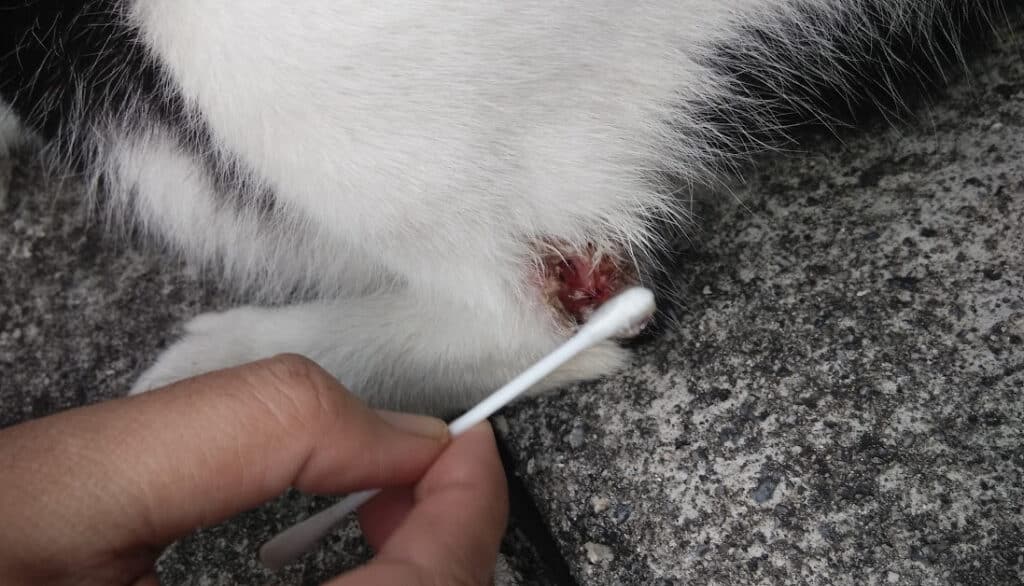What is Witch Hazel?
Witch Hazel is an astringent derived from the bark and leaves of the Witch Hazel plant. It has been used for centuries in traditional medicine due to its anti-inflammatory, antiseptic, and pain-relieving properties. Witch Hazel is commonly used to treat skin conditions such as acne, eczema, and psoriasis. It can also be used to treat minor cuts, bruises, and insect bites due to its soothing effect on the skin. But can you use witch hazel on dogs?
Witch Hazel can be used on dogs to clean wounds and soothe irritated skin. Its anti-inflammatory properties make it effective in reducing swelling and inflammation caused by insect bites or allergies. However, it should always be diluted before use, as pure Witch Hazel can cause irritation to their sensitive skin.
Overall, when using Witch Hazel on dogs or humans, it is important to follow the manufacturer’s instructions carefully and consult with a veterinarian if any adverse reactions occur.

Benefits of Using Witch Hazel on Dogs
Witch Hazel’s Advantages on Canines
Witch hazel, an astringent obtained from the bark and leaves of Hamamelis virginiana, has numerous benefits when used on dogs. Some of them are:
- Eliminates Odor: Witch hazel is known for its ability to remove unpleasant pet odors. It removes excess oil and dirt from your dog’s skin and coat, leaving it smelling better.
- Treats Insect Bites And Stings: Witch hazel is an effective natural remedy for insect stings and bites. Its anti-inflammatory properties help alleviate itchiness, swelling, and pain when applied topically on the affected area.
- Cleans Wounds: Witch hazel is a natural antiseptic that cleanses wounds without causing further damage. It eases pain and inflammation while healing the wound quickly.
Additionally, witch hazel can provide relief for hot spots, dry skin, and allergies in dogs without any side effects.
Overall, witch hazel has many advantages when used on dogs due to its hypoallergenic qualities making it safe for almost all canines with little to no side effects.

How to Prepare Witch Hazel for Dog Care
To get the most out of witch hazel for your furry friend, it’s essential to know how to prepare it correctly. Follow these simple steps for preparing witch hazel for dog care.
- Begin by gathering all the necessary ingredients, such as fresh or dried witch hazel leaves, distilled water and cheesecloth.
- Clean and sterilize a glass jar that’s big enough to hold all the ingredients.
- If using fresh leaves, crush them before adding them to the jar. If using dried leaves, add them directly into the jar.
- Add enough distilled water to cover the leaves completely.
- Seal the jar and store it in a cool, dry place for 1-2 weeks to allow infusion of the witch hazel solution, shaking periodically.
- When ready, strain out the plant material using cheesecloth and pour the liquid into an appropriate spray bottle or storage container for later use.
Witch hazel can be highly effective when used appropriately on dogs. However, keep in mind that its usage varies depending on your dog’s individual needs. Therefore, it’s advisable to seek veterinarian advice first before applying any treatment options involving witch hazel.

Common Uses of Witch Hazel on Dogs
To effectively utilize witch hazel on your furry friend, it’s crucial to understand its common uses. This section on “Common Uses of Witch Hazel on Dogs” with sub-sections on “Soothe Skin Irritations, Clean Wounds and Cuts, Ear Cleaning, and Flea and Tick Prevention” will provide you with the necessary knowledge to incorporate witch hazel safely and effectively into your dog’s healthcare routine.
Soothe Skin Irritations
Witch hazel has been used for centuries to alleviate skin irritations in humans and dogs alike. This natural astringent acts as an anti-inflammatory agent by constricting blood vessels, reducing swelling and itching, and calming irritated skin. Using witch hazel on your dog can help soothe hot spots, eczema, dermatitis, insect bites, and other skin issues. Its gentle properties make it an ideal remedy for sensitive areas such as the face and paws. When using witch hazel on your pet, dilute it with water to avoid any further irritation.
Aside from its ability to calm skin irritations, witch hazel can also serve as a natural cleaning solution for your dog’s ears. Its anti-inflammatory properties make it effective in treating ear infections caused by bacterial or fungal growth . Simply soak a cotton ball in diluted witch hazel and gently clean the inside of your dog’s ear canal.
It is worth noting that excessive use of witch hazel can have adverse effects on your pet’s health. Ingestion of this solution can cause vomiting, diarrhea, and other digestive issues. Therefore, it is crucial to use witch hazel sparingly and under veterinary guidance.

Clean Wounds and Cuts
Witch hazel has become a popular natural remedy for various dog-related skin conditions. One of its common uses is to sanitize and disinfect cuts and wounds.
To clean wounds and cuts with witch hazel, follow these 3 simple steps:
- Start by trimming the fur around the affected area, if necessary. This will prevent any stray hairs from entering the wound when cleaning.
- Gently wash the wound with an antiseptic soap and rinse thoroughly with warm water. Pat dry with a clean towel.
- Apply a small amount of witch hazel to a cotton ball or gauze pad and gently dab it onto the wound. Allow it to air-dry before covering with a bandage or dressing.
Apart from cleaning wounds, it’s important to note that witch hazel also has anti-inflammatory properties that can help reduce swelling and soothe irritated skin. However, consult your vet before using it for any specific skin condition.

Ear Cleaning
Witch Hazel solution can be an effective way to clean a dog’s ears. It is a natural astringent that can help dry up any excess moisture, making it ideal for pets who swim regularly or have floppy ears. Here are some points on how to safely incorporate Witch Hazel in ear cleaning:
- First, check for any signs of ear infections by examining your pet’s inner ears and smelling for any foul odors or discharge.
- If everything looks healthy, moisten a cotton ball with Witch Hazel and gently wipe the inside of your dog’s ear flap.
- Never insert anything into your dog’s ear canal as this could cause damage or discomfort.
- For dogs with more significant ear issues, consult with your veterinarian before using any home remedies like Witch Hazel solution.
It’s essential to stick to regular cleaning routines that keep your pet free of infections. Using Witch Hazel in moderation may help prevent these issues from arising. Remember not to overuse it and always monitor your furry friend while doing so!

Flea and Tick Prevention
Witch Hazel for Parasite Control
Witch hazel has been known to act as a natural flea and tick preventative method for dogs. Here are 6 ways witch hazel can help to control parasites on your furry friend:
- Dilute witch hazel with water, so it becomes safe for direct application on the dog’s skin.
- Apply the solution on areas that fleas or ticks tend to occupy, such as the neck or behind the ears.
- Witch hazel acts as an astringent, which means that it will cause pores to contract. This helps by closing off locations where parasites may find entry into your pet’s skin.
- To increase efficiency, this treatment can be complemented with other natural remedies like diatomaceous earth powder and cedar oil.
- Witch hazel also works well in treating hot spots caused by scratching infested bites. It reduces inflammation and promotes healing.
- Since witch hazel helps improves coat health, applying it regularly can keep pests away.
It is important to note that while witch hazel is a natural treatment solution, always consult with your veterinarian before starting any new treatment regime.
Using Astringents
Apart from controlling parasites, using astringents like witch hazel can also have other benefits for your canine companion. The topical application of these substances can clean and sterilize wounds from parasite bites; additionally, they improve the appearance of their skin and coat.
In summary, holistic solutions that can benefit dogs include using natural astringents like witch hazel. In addition to its uses in parasite control, there are various additional applications for promoting overall wellness in pets.

Safety Precautions When Using Witch Hazel on Dogs
When using Witch Hazel on dogs, certain safety measures need to be taken to avoid any harmful effects or potential risks. These precautions are essential to ensure your dog’s well-being and comfort.
- Always dilute witch hazel before application.
- Avoid contact with your dog’s eyes, nose or mouth.
- Avoid prolonged use of witch hazel on the same area of the skin.
- Consult a veterinarian before using witch hazel on dogs with skin allergies or other medical conditions.
- Ensure your dog does not ingest witch hazel as it can be toxic in large quantities.
It is important to note that Witch Hazel should only be used externally on dogs and should never replace prescribed medications from a veterinarian. While it can provide relief for various skin irritations, such as itching, inflammation and minor wounds, it does not treat underlying medical conditions.
Though there are many natural remedies available for common pet ailments, always seek advice from a licensed veterinarian before applying any product onto your pet’s delicate skin. Your veterinarian can advise you on the proper usage and dosage for these remedies and offer advice on selecting safe alternatives if necessary.
Frequently Asked Questions
Yes, witch hazel is safe for dogs to use topically for skin irritations or cleansing wounds.
Witch hazel is commonly used as a natural astringent to help soothe skin irritations, reduce inflammation and redness, and cleanse wounds.
Yes, using witch hazel on a dog’s itchy skin can help calm and soothe the irritation. However, it should not be used on open wounds or sensitive areas.
First, clean the affected area with a mild soap and warm water. Then, saturate a cotton ball or pad with witch hazel and gently apply it to the affected area. Do not allow your dog to lick or ingest the witch hazel.
In rare cases, dogs may have an allergic reaction to witch hazel. It is important to monitor your dog closely after applying and discontinue use if you notice any adverse effects.
No, witch hazel should not be used as a replacement for veterinary care. While it can be helpful for minor skin irritations, serious or chronic conditions require professional medical attention.
